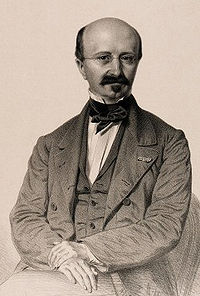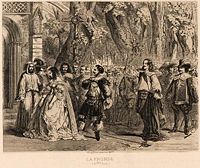
Louis Niedermeyer
Encyclopedia


Composer
A composer is a person who creates music, either by musical notation or oral tradition, for interpretation and performance, or through direct manipulation of sonic material through electronic media...
chiefly of church music
Church music
Church music may be defined as music written for performance in church, or any musical setting of ecclestiacal liturgy, or music set to words expressing propositions of a sacred nature, such as a hymn. This article covers music in the Judaeo-Christian tradition. For sacred music outside this...
but also of a few opera
Opera
Opera is an art form in which singers and musicians perform a dramatic work combining text and musical score, usually in a theatrical setting. Opera incorporates many of the elements of spoken theatre, such as acting, scenery, and costumes and sometimes includes dance...
s, and a teacher who took over the Ecole Choron, duly renamed École Niedermeyer, a school for the study and practice of church music, where several eminent French musicians studied including Gabriel Fauré
Gabriel Fauré
Gabriel Urbain Fauré was a French composer, organist, pianist and teacher. He was one of the foremost French composers of his generation, and his musical style influenced many 20th century composers...
and André Messager
André Messager
André Charles Prosper Messager , was a French composer, organist, pianist, conductor and administrator. His stage compositions included ballets and 30 opéra comiques and operettas, among which Véronique, had lasting success, with Les p'tites Michu and Monsieur Beaucaire also enjoying international...
.
Born in Nyon
Nyon
Nyon is a municipality in the district of Nyon in the canton of Vaud in Switzerland. It is located some 25 kilometers north east of Geneva's city centre, and since the 1970s it has become part of the Geneva metropolitan area. It lies on the shores of Lake Geneva, and is the seat of the district of...
, Switzerland
Switzerland
Switzerland name of one of the Swiss cantons. ; ; ; or ), in its full name the Swiss Confederation , is a federal republic consisting of 26 cantons, with Bern as the seat of the federal authorities. The country is situated in Western Europe,Or Central Europe depending on the definition....
, Niedermeyer studied piano
Piano
The piano is a musical instrument played by means of a keyboard. It is one of the most popular instruments in the world. Widely used in classical and jazz music for solo performances, ensemble use, chamber music and accompaniment, the piano is also very popular as an aid to composing and rehearsal...
in Vienna
Vienna
Vienna is the capital and largest city of the Republic of Austria and one of the nine states of Austria. Vienna is Austria's primary city, with a population of about 1.723 million , and is by far the largest city in Austria, as well as its cultural, economic, and political centre...
with Ignaz Moscheles
Ignaz Moscheles
Ignaz Moscheles was a Bohemian composer and piano virtuoso, whose career after his early years was based initially in London, and later at Leipzig, where he succeeded his friend and sometime pupil Felix Mendelssohn as head of the Conservatoire.-Sources:Much of what we know about Moscheles's life...
and composition with Emanuel Aloys Förster
Emanuel Aloys Förster
Emanuel Aloys Förster , was a composer and music teacher, who spent most of his life in Vienna, Austria.- Early life :...
. He studied further in Rome
Rome
Rome is the capital of Italy and the country's largest and most populated city and comune, with over 2.7 million residents in . The city is located in the central-western portion of the Italian Peninsula, on the Tiber River within the Lazio region of Italy.Rome's history spans two and a half...
with Vincenzo Fioravanti (1819) and in Naples
Naples
Naples is a city in Southern Italy, situated on the country's west coast by the Gulf of Naples. Lying between two notable volcanic regions, Mount Vesuvius and the Phlegraean Fields, it is the capital of the region of Campania and of the province of Naples...
with Niccolò Antonio Zingarelli
Niccolò Antonio Zingarelli
Niccolò Antonio Zingarelli was an Italian composer, chiefly of opera.-Early career:Zingarelli was born in Naples, where he studied at the Santa Maria di Loreto Conservatory under Fenaroli and Speranza....
. While in Rome, he had the luck to meet Gioachino Rossini, who befriended him and urged the production of some of Niedermeyer's operas. His first opera, Il reo per amore, was put on in Naples in 1820 with some success.
Like Rossini, Niedermeyer settled in Paris
Paris
Paris is the capital and largest city in France, situated on the river Seine, in northern France, at the heart of the Île-de-France region...
(at the age of 21, in 1823); and there, in later years, four more of his operas were staged, though with little success:
- La casa nel bosco (28 May 1828)
- StradellaStradella (opera)Stradella is a Grand Opera in five acts by Louis Niedermeyer to a libretto by Emile Deschamps and Emilien Pacini. Based on a highly romanticized version of the life of the composer Alessandro Stradella , it was premiered at the Paris Opéra on 3 March 1837.-Background:The storyline of the opera is...
(3 March 1837) - Marie StuartMarie Stuart (opera)Marie Stuart is a grand opera in five acts composed by Louis Niedermeyer to a libretto by Théodor Anne loosely based on events in the life of Mary, Queen of Scots...
(6 December 1844) - La Fronde (2 May 1853)
Niedermeyer also collaborated with his friend Rossini on the assembly of Robert Bruce, Rossini's third and last pastiche
Pastiche
A pastiche is a literary or other artistic genre or technique that is a "hodge-podge" or imitation. The word is also a linguistic term used to describe an early stage in the development of a pidgin language.-Hodge-podge:...
; Niedermeyer provided the all-important French texts with their characteristic tone color
Timbre
In music, timbre is the quality of a musical note or sound or tone that distinguishes different types of sound production, such as voices and musical instruments, such as string instruments, wind instruments, and percussion instruments. The physical characteristics of sound that determine the...
and harmonies
Harmony
In music, harmony is the use of simultaneous pitches , or chords. The study of harmony involves chords and their construction and chord progressions and the principles of connection that govern them. Harmony is often said to refer to the "vertical" aspect of music, as distinguished from melodic...
.
After these attempts at an operatic career Niedermeyer devoted himself primarily to sacred and secular vocal music. In October 1853, he reorganized and re-opened the school then known as the Ecole Choron (after Alexandre-Étienne Choron
Alexandre-Étienne Choron
Alexandre-Étienne Choron for a short time directed the Paris Opera. He played an essential role in France in making a clear distinction between sacred and secular music, and was one of the originators of French interest in musicology.- Biography :Choron studied mathematics at the collège de Juilly...
, who had died in 1834). It was renamed the École Niedermeyer. Although it has had further name changes, the school is still open.
His church music remained in use in France and elsewhere into the 20th century. Although he studied in Austria and Italy, he is generally described today as a French composer because of his chosen country of residence.
He died in Paris.

